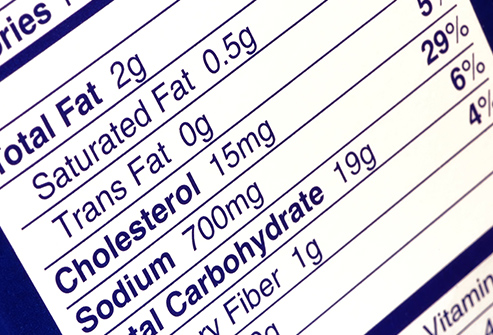45 reading food labels for cholesterol
How to Read Nutrition Labels: Fat Content, Carbs & What To Look For Nutrition labels are required to include total fat, saturated fat, and trans fat. The total amount of fat in the diet is a percentage of your calorie needs. The recommendation for the typical American diet is around 30%. For someone taking in 2,000 calories, this would mean around 70 grams of total fat per day. How to Read Food Labels : Food Network | Food Network The percent of the Daily Value that is listed on the upper portion of the food label is yet another way to gauge how much saturated fat and cholesterol are in the foods that you buy and eat. If a...
Interactive Nutrition Facts Label The Nutrition Facts label on food and beverage packages shows the amount in milligrams (mg) and the % Daily Value (%DV) of cholesterol per serving of the food. The Daily Value for cholesterol is less than 300 mg per day. Compare and choose foods to get less than 100% DV of cholesterol each day. And remember:
Reading food labels for cholesterol
PDF Interactive Nutrition Facts Label - Cholesterol Interactive Nutrition Facts Label • March 2020 Cholesterol 1 Cholesterol What It Is Cholesterol is a waxy, fat-like substance found in all cells . of the body. Cholesterol is produced by the body (primarily by the liver) and is also consumed from food, referred to as "dietary cholesterol." How to Read the Nutrition Facts Label on Packaged Foods Limit salt to 2,300 milligrams (about 1 teaspoon) daily. If you have high blood pressure, kidney disease, or diabetes, or are African-American or older than 51, your daily limit is lower: 1,500... Reading food labels: Tips if you have diabetes - Mayo Clinic Look for foods with fats, cholesterol and sodium on the low end of the Daily Value; keep fiber, vitamins and minerals on the high end. If your doctor or registered dietitian recommends more or less than 2,000 calories a day, you may need to adjust the percentage accordingly — or simply use the percentage as a general frame of reference.
Reading food labels for cholesterol. Reading Food Labels - What You Need to Know - Drugs.com Reading labels may also help you to eat less of the nutrients that could cause health problems. Eating too much fat, saturated (SACH-er-ay-ted) fat, trans fat, cholesterol (koh-LES-ter-ol) and sodium may increase your risk for certain health problems. Some of these health problems are heart disease and high blood pressure. How to understand food labels - Eat For Health Sometimes labels will include nutrition content claims like 'low fat', 'reduced salt' or 'high fibre'. These claims can only be used if the food meets certain criteria. For example, with a 'good source of calcium' claim, the food must contain more than a set amount of calcium. While nutrition content claims can generally guide ... › food › new-nutrition-facts-labelHow to Understand and Use the Nutrition Facts Label | FDA Feb 25, 2022 · People look at food labels for a variety of reasons. ... The following label-reading skills are intended to make it easier for you to use the Nutrition Facts labels to make quick, informed food ... Food Labels: Fat & Cholesterol | Home & Garden Information Center Limit these sources of unhealthy fat and cholesterol in the list of ingredients: animal fat (beef, ham, pork, bacon, lamb, chicken, turkey), lard, hardened fat or oil, egg and egg-yolk solids, cream, butter, whole-milk solids, palm oil, palm kernel oil, hydrogenated vegetable oil, vegetable shortening, coconut, coconut oil, and cocoa butter.
How to Read a Food Label - WebMD For example, "trans-fat free" or "fat-free" products can have only 0.5 mg of trans fats or fat; "cholesterol-free" foods can only have 2 milligrams of cholesterol and 2 grams of saturated fat. How To Read Food Labels - 10 Tips | Pritikin Program For Eating Right Here are the basics for how to read food labels, consolidated into 10 quick-reference tips, compliments of Kimberly Gomer, Director of Nutrition at the Pritikin Longevity Center in Miami, Florida. These 10 tips are all about helping you shed excess weight, take good care of your heart, and live well. 1. Reading food labels | Heart Foundation Reading food labels Nutrition information panels and ingredients lists are a good way of comparing similar foods so you can choose the healthiest option. ... Other nutrients such as vitamins and minerals, fibre and other types of fat (unsaturated, trans, cholesterol) may also be listed. Comparing products When comparing products, look at the ... Reading food labels: Tips if you have diabetes - Mayo Clinic Look for foods with fats, cholesterol and sodium on the low end of the Daily Value; keep fiber, vitamins and minerals on the high end. If your doctor or registered dietitian recommends more or less than 2,000 calories a day, you may need to adjust the percentage accordingly — or simply use the percentage as a general frame of reference.
How to Read the Nutrition Facts Label on Packaged Foods Limit salt to 2,300 milligrams (about 1 teaspoon) daily. If you have high blood pressure, kidney disease, or diabetes, or are African-American or older than 51, your daily limit is lower: 1,500... PDF Interactive Nutrition Facts Label - Cholesterol Interactive Nutrition Facts Label • March 2020 Cholesterol 1 Cholesterol What It Is Cholesterol is a waxy, fat-like substance found in all cells . of the body. Cholesterol is produced by the body (primarily by the liver) and is also consumed from food, referred to as "dietary cholesterol."

28 Food Infographics – Valuable Kitchen Tips, Hacks and Cheats to Make Life Easier - Page 2 of 5 ...

An Easy Guide to Reading Food Labels. If you want to discover what’s really in your food ...

Food Label Misconceptions | Reading food labels, Cholesterol, Cholesterol lowering foods





Post a Comment for "45 reading food labels for cholesterol"